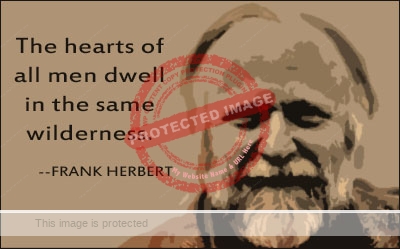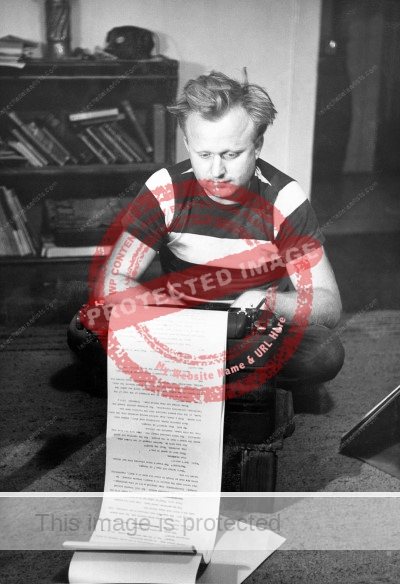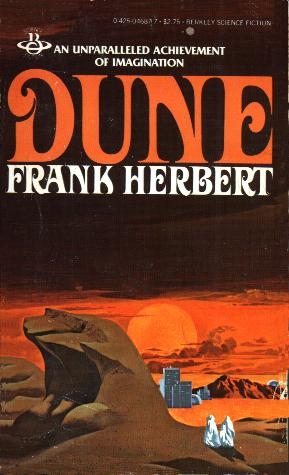Near the start of his writing career, an impecunious Frank Herbert, the genius behind the epic science fiction novel Dune, lived in the town of Chapala for several months. It was September 1953 and Herbert was 32 years old and struggling to make a living as a writer.
Herbert would not have been in Chapala at all had he not met fantasy writer Jack Vance for the first time a year earlier. The two men were about the same age, but Vance was already a successful writer known for his science fiction “pulps” and was making decent money writing scripts for Captain Video, a popular TV show. Herbert was a reporter for the Santa Rosa Press Democrat, had not yet found much success as a writer, and was struggling to pay the family bills.

As the two men got to know each other they talked of joint writing projects and of the two families traveling together to Mexico in search of new experiences and stimulation for their work.
This joint trip to Mexico, endearingly told by Herbert’s elder son, Brian, in Dreamer of Dune: The Biography of Frank Herbert, was the start of one of the greatest literary bromances related to Lake Chapala. Brian was only six years old at the time so much of what he writes is presumably based on notes written by his father and recollections shared by his mother, Beverly.
Vance and his wife Norma bought a new blue Jeep station wagon for the trip and the families shared driving, expenses and domestic tasks. After stopping briefly at a roadside monument marking the Tropic of Cancer, Norma accidentally left her purse on the car as they drove away. By the time they made a quick U-turn to recover the purse, which contained Jack’s favorite fountain pen (Vance was accustomed to writing long-hand whereas Herbert used a typewriter), it had been run over by another vehicle and the pen squashed.
A few days later they reached Chapala and rented a large house in the village. Brian Herbert describes the lake and surrounding farmland before writing that,
“A fishing and artists’ colony, Chapala was much favored by tourists, especially Americans. The town, while small, boasted one of the world’s great beer gardens – a large tavern by the lake that had outdoor seating under a shady, striped canvas roof. On hot days, my parents and the Vances could be found there, cooling themselves in the shade. Sunsets on the lake were spectacular.”
The “two-story adobe and white stucco house, which had been converted to a duplex” rental property was on the hillside a block from the lake. Strict silence was enforced during the mid-morning to mid-afternoon “writing hours”, so that both men could concentrate on developing plots and characters.

Frank Herbert, 1952. Photo by Jack Vance (used in Jorgensen 2014 by courtesy of Jack Vance estate)
While the writers did cooperate on some “joint ventures” while in Chapala, each of them also wrote short stories, hoping to sell some to magazines north of the border and thereby extend their stay in Mexico. Herbert was also working on a psychological thriller set in a submarine, serialized in Astounding magazine as “Under Pressure”, and later turned into the book The Dragon in the Sea (1956).
Herbert also completed a humorous short piece entitled “Life with Animalitos”, submitted to Reader’s Digest but never published.
After two months in Chapala, with funds running low, the Vances and Herberts decided to move to the larger, lower-cost city of Ciudad Guzmán in southern Jalisco. Shortly after arriving in the city, Herbert was invited to the home of a retired Mexican Army general. When sweet cookies were brought round, Herbert hungrily consumed two before discovering they were laced “with the most expensive North African hashish in the world” and experiencing hallucinations.
This was the initial experience that gave Herbert the idea for melange, the fictional spice found only on the planet Dune that was “the most important substance in the universe”. According to Herbert’s son, “Paul Atreides’s experiences with that drug [in the novel] mirror the author’s personal experiences.”
After about a month in Ciudad Guzmán, and almost out of funds, the group returned to the U.S. and then shared the Vances’ farmhouse in Kenwood, California, for several weeks.

Herbert eventually found his financial footing, in part by writing speeches for Republican senator Guy Cordon. In 1959 he began work on Dune (published as a hardback in 1965) which opened all kinds of literary doors and enabled him to achieve the success he had previously only dreamed about.
Dune, one of the most popular science fiction novels ever written, won the Nebula Award for Best Novel in 1965 and was the first major ecological science fiction novel. The movie version of Dune in 1984, screenplay by David Lynch, was shot entirely in Mexico: at Churubusco Studios, Mexico City; Samalayuca sand dunes in Chihuahua; and at Puerto Peñasco and the nearby El Pinacate y Gran Desierto de Altar in Sonora.
Many elements from Dune – including warring noble houses, “aura” spice and “moisture farming” – are evident in the later Star Wars movies. Herbert was the first to recognize this and formed, with a number of like-minded colleagues a lighthearted club called the “We’re Too Big to Sue George Lucas Society”.
Herbert wrote more than twenty other novels, including The Green Brain (1966), The Santaroga Barrier (1968), Hellstrom’s Hive (1973), The Dosadi Experiment(1977) and The White Plague (1982).
Science fiction fans everywhere should be eternally grateful that Frank Herbert accompanied his friend Jack Vance to Chapala, and that he then ate those two cookies at the General’s house in Ciudad Guzmán.
Frank Patrick Herbert, Jr., was born on 8 October 1920 in Tacoma, Washington, and died on 11 February 1986 in Madison, Wisconsin.
Sources:
- Brian Herbert. 2003. Dreamer of Dune: the biography of Frank Herbert. (New York: Tom Doherty Associates).
- Erik Jorgensen. 2014. “‘The Spice’ Flows From Santa Rosa“, Oak Leaf (SRJC’s Student Newspaper), 8 December 2014.
- David B Williams. “Vance Museum – Miscellany – Biographical Sketch“.
- Wikipedia. Frank Herbert.
Sombrero Books welcomes comments, corrections or additional material related to any of the writers and artists featured in our series of mini-bios. Please email us or use the comments feature at the bottom of individual posts.
Tony Burton’s books include “Lake Chapala: A Postcard History” (2022), “Foreign Footprints in Ajijic” (2022), “If Walls Could Talk: Chapala’s historic buildings and their former occupants” (2020), (available in translation as “Si Las Paredes Hablaran”), “Mexican Kaleidoscope” (2016), and “Lake Chapala Through the Ages” (2008).
My first citation in a scholarly article! I should mention the cool photograph of Frank Herbert, typing on a roll of paper even Jack Kerouac would be envious of, was courtesy of the Jack Vance estate and not from my private collection.
A revised version of my article is available in my FREE ebook, which also includes historical articles about Philip K Dick, and about Jack London’s near-forgotten sci-fi stories:
http://www.smashwords.com/books/view/766141
Thanks for the clarification, and congratulations on your new ebook which I look forward to reading.